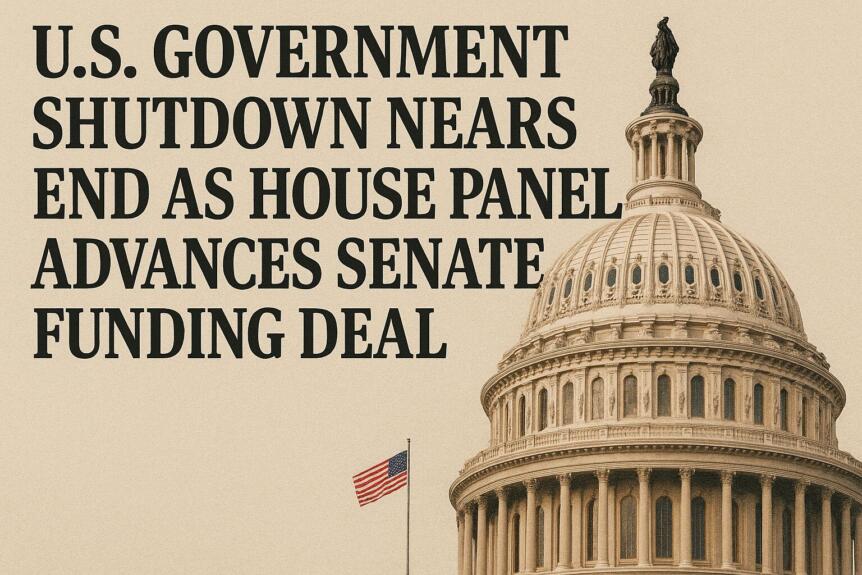U.S. Government Shutdown Nears End as House Panel Advances Senate Funding Deal

The U.S. government shutdown may soon be brought to an end following a House Rules Committee vote to pass a bill aimed at funding the operation of the Senate. This bill that seeks to reopen federal agencies is a decisive move towards ending the current deadlock. Should the entire House approve the bill, it would reimburse funding to most federal agencies until January 30, 2026. It is likely to have a vote in the House as early as Wednesday afternoon, after the committee has approved.
House Panel Clears Path for Final Vote
The House Rules Committee passed the bill by a 8-4 party vote and the Bill was sent to the full House. This procedural vote is in lieu of the bill being voted through by a 60 to 40 majority vote in the Senate on Monday. The Senate passed the measure with a majority, which indicated that both parties worked together, but some of the amendments by the Democrats were turned down.
Such amendments would have increased subsidies on health insurance and prevented a law permitting senators to sue for $500,000 should law enforcement take their data. There were warnings to the lawmakers that they would postpone the bill further, and it would be sent to the senate to be revised.
The House Speaker, Mike Johnson, has been calling on Congressmen to come back to Washington to expect the vote. He advised against possible travel disruptions at key airports since the FAA had been on a holiday as both chambers had been out over the Veterans Day holiday. After the House has voted, the bill will be sent to the desk of President Trump to be formally passed and the shutdown will be over.
Impact on the Market and U.S. Government Reopening Prospects
The funding bill passed is following a series of unsuccessful moves to settle on a deal. This development, after weeks of stalemate, suggests possible bipartisan cooperation in the future. The consensus among the experts has always been that the solution to the U.S. government shut could lead to a market rally. Such shutdowns in the past have led to liquidity inflows, which have enhanced investor sentiment. Indeed, in 2019, as the government shutdown was removed, Bitcoin increased by 266 percent in subsequent months.
Sistine Research analysts have opined that some of the tokens might be good as the shutdown comes to an end. XRP is also in the spotlight and as some critics call it the fastest horse in this race. With the government activities back in business, a chance to revive trust in the market exists, and more sentiment around digital assets such as XRP will be raised.
Notwithstanding this, Bitcoin has undergone certain difficulties during the shutdown. It is currently at a price of approximately 103,000 as compared to the start of the shutdown in early October, when the price dropped by 14 percent. The volatility has been worsened by the increasing trade tension, yet the market is yet to get the positive catalysts.
In the meantime, the draft Crypto Asset Market Clarity Act has also been presented by the U.S. Senate Committee that has the potential to increase the power of the CFTC to regulate digital assets. This action indicates that the government has been paying more attention to the regulation of the digital asset space and may have some consequences in the market in the future.
21Shares XRP ETF and the Potential Market Shift
The other major change in the crypto sphere is the continued release of the 21Shares XRP ETF. The institutionalization of crypto assets such as XRP may be further institutionalized by the fund that is bound to track the price fluctuations of XRP. The 21Shares XRP ETF is attracting attention because of its ability to expand the investor’s reach to the digital world via a more regulated platform.
The passage of the funding bill and the further increase of institutional interest might precondition the further changes in the market, and the 21Shares XRP ETF may become the key to the market transformation. The ETF will introduce additional institutional investors to the crypto market, which can make the latter more liquid and stable in the long run, which is beneficial to XRP.
This article was originally published as U.S. Government Shutdown Nears End as House Panel Advances Senate Funding Deal on Crypto Breaking News – your trusted source for crypto news, Bitcoin news, and blockchain updates.
También te puede interesar

Top Cryptocurrency to Buy Under $0.1 This Month? This New Crypto Could Surge 650%

Bitcoin Loans Usher In a New BTC Era – Bitcoin Hyper Tipped as the Next 1000x Crypto
